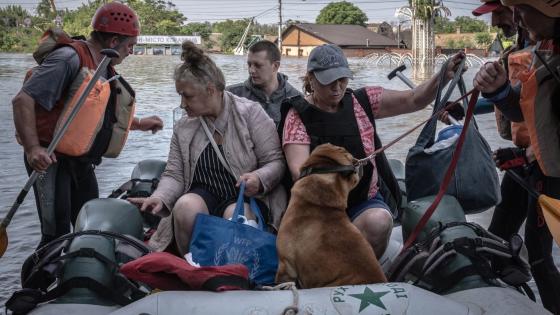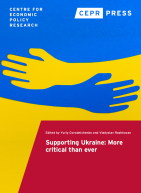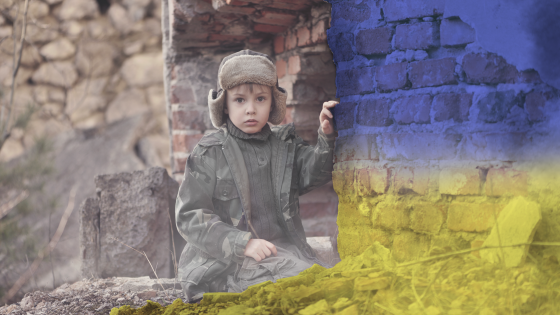The collapse of the Kakhovka Dam on 6 June 2023 is one of several disasters due to Russia’s invasion of Ukraine. Alongside the Bucha massacre, the bombing of Mariupol’s maternity hospital, the Azovstal Steel Works siege and the abduction of thousands of Ukrainian children, to name a few, the destruction of the Kakhovka Dam has long-term deleterious effects on Ukraine’s society.
The Kakhovka Dam held 18 cubic kilometres of water, equivalent to the Great Salt Lake in the US. The short-term economic losses are large. First, for two weeks after the collapse of the dam, hydroelectric stations on the Dnipro River cut down output in order to limit downstream water flow. Second, industrial production in the affected area ceased, due to the lack of water supply for production purposes. Third, 31 irrigation systems in the Dnipropetrovsk, Kherson, and Zaporizhzhia regions were destroyed. This loss alone means that nearly 600,000 hectares of arable land have lost irrigation, reducing Ukraine’s 2023 harvest of grains and oil crops by approximately 4 million tonnes (based on 2021 yields), valued at $1.5 billion in export volumes (Blinov and Djankov 2023).
The long-term environmental damage is large too. At least 150 metric tonnes of oil and 60 metric tonnes of chemicals have leaked out into the Dnipro River en route to the Black Sea. Poisonous substances have joined the waterflow downstream from flooded gas stations, factories, and sewage facilities (KSE Institute 2023).
A discussion is already underway about how Ukraine will be reconstructed in the war’s aftermath and the assistance the country will require (e.g. Gorodnichenko et al. 2022, Mylovanov and Roland 2023). The Kakhovka disaster adds to the tally of reconstruction needs, which span from investments into infrastructure to agriculture and education (Blinov and Djankov 2022a, 2022b, Gorodnichenko and Rashkovan 2023, Svejnar 2023).
Few precedents
There have been few precedents to this disaster. The most well-documented similar event took place in China nearly a century ago. In 1931, due to miscalculations of water needs by irrigation experts after a long drought, water overwhelmed the banks of the Yangtze and Huai Rivers, resulting in the Central China flood. Contemporary studies (e.g. Buck 1932) allege that at least 150,000 people drowned in the first days of the flood, with hundreds of thousands more dying of starvation and disease over the following months. The flood destroyed huge amounts of housing and farmland. Throughout the entire Yangtze Valley, around 15% of the wheat and rice crops were destroyed (Kueh 1995). The combined economic and environmental impacts of the disaster caused many areas to descend into famine (Courtney 2018). The most lethal effect of the flood was the diseases that swept through the displaced population due to overcrowding and the breakdown of sanitation (National Flood Relief Commission 1933).
Another example, eerily reminiscent of the Kakhovka Dam disaster, comes from Ukraine. In August 1941, with Nazi troops advancing through Soviet-era Ukraine, Josef Stalin ordered the destruction of the DniproHES hydroelectric dam in the city of Zaporizhzhya, to slow the German advance. The breach swamped villages along the Dnipro river, killing thousands of civilians and retreating Soviet troops. Historians put the death toll at between 20,000 and 100,000, based on the number of people then living in the flooded areas (Pokhy 2017).
Economic costs
The immediate economic costs of the Kakhovka Dam disaster amount to nearly $4 billion. According to a study by the KSE Institute (2023), the housing sector has suffered losses in the settlements of Kherson and Mykolaiv regions. In the Mykolaiv region, over 500 private houses in rural areas have been flooded. In the Kherson region, it is not possible to determine the exact number of damaged or destroyed residential buildings due to the partial temporary occupation by Russian troops. However, aerial imagery suggests that approximately 20,000 houses have been affected by flooding, including at least 150 multi-story buildings in the city of Kherson. Direct damages from the flooding of private houses and related infrastructure are estimated at $950 million, with the majority concentrated on the left bank of the Dnipro River.
Additionally, Ukraine has incurred losses in the construction of water pipelines. Due to the decrease in the water level in the Kakhovka Dam, a significant part of the Dnipropetrovsk, Zaporizhia, Mykolaiv, and Kherson regions are left without water supply. To address the consequences of the destruction of the hydroelectric power station, the budget committee in the Ukrainian parliament approved in mid-June the allocation of approximately $40 million for the construction of main water pipelines.
The Kakhovka Dam was used to supply water for livestock farming across a total area of 584,000 hectares. As a result, losses from the disruption of livestock agriculture are projected to reach $200 million annually. The loss of irrigation systems means that nearly 600,000 hectares are temporarily left barren, reducing Ukraine’s 2023 agricultural exports by $1.5 billion in trading volumes (Blinov and Djankov 2023).
The energy sector accounts for a large share of the total damages caused by the explosion at the hydroelectric power plant, amounting to $600 million. The annual economic losses incurred by the state-owned company Ukrhydroenergo due to the destruction of the power station exceed a further $100 million. The restoration needs for the new hydroelectric power plant of the same installed capacity would amount to nearly $1 billion (KSE Institute 2023).
The industrial sector and other businesses have incurred damages amounting to an estimated $150 million. The flood-related damages to businesses were mitigated by the fact that some enterprises had relocated earlier or ceased operations due to the temporary occupation by Russian soldiers.
Environmental costs
Separately from the immediate economic costs, the estimated amount of losses caused to the environment is approximately $2 billion. First, experts say that the destruction of the dam will affect the drainage of the Dnipro riverbed, with consequences including sandstorms, accelerated climate change, and the desertification of neighbouring regions. These effects are most likely to be felt in Kherson, Zaporizhzhia, Dnipro, and Donetsk regions, where they will add to the largest desert in Europe, the Oleshky Sands, located inland from the Black Sea. The cost for the Dnipro cleanup is estimated at $1.5 billion (KSE Institute 2023).
A second problem is that not all farm animals were evacuated on time and their corpses have posed an epidemic threat to other animal populations. The steppe areas, where many rare Red Data Book animals live, are still exposed to this threat, with the loss of a large number of rare animals. Repopulation of the steppes may cost a half billion dollars.
Who will pay for reconstruction of Kakhovka?
Various proposals have been put forward on financing the post-war recovery (see papers in Gorodnichenko and Rashkovan 2023). These proposals invariably involve large amounts of aid from Western donors as well as reparations by Russia. The priorities differ somewhat across proposals though they uniformly focus on rebuilding human capital and infrastructure. The reconstruction of the Kakhovka Dam is both: it allows for recovering and upgrading the livelihood of tens of thousands of farmers along the Dnipro, while also meeting critical energy needs.
Just like the DniproHES dam was rehabilitated after WWII to serve the post-war Ukrainian economy, so too can the Kakhovka Dam. There may be a temptation to speed up the post-war recovery by implementing emergency public procurement for such projects. Instead, regular procurement rules should be followed from the start, to ensure quality and competitive prices (Bosio et al. 2022).
References
Blinov, O and S Djankov (2023), “An all-out aggression requires an all-out response”, in Y Gorodnichenko and V Rashkovan (eds) (2023), Supporting Ukraine: More critical than ever, CEPR Press.
Blinov, O and S Djankov (2022a), “The economic toll of attacks on Ukraine’s power grid,” VoxEU.org, 21 December
Blinov, O and S Djankov (2022b), “Restarting Ukraine’s agricultural exports,” VoxEU.org, 10 June.
Bosio, E, S Djankov, E Glaeser, and A Shleifer (2022), “Public procurement in law and practice”, American Economic Review 112(4): 1091–117.
Buck, J (1932), The 1931 flood in China: an economic survey by the Department of Agricultural Economics, College of Agriculture and Forestry, the University of Nanking, in cooperation with the National Flood Relief Commission, Nanking: University of Nanking.
Courtney, C (2018), The Nature of Disaster in China The 1931 Yangzi River Flood, Cambridge University Press.
Gorodnichenko, Y, I Sologoub and B Weder di Mauro (2023), Rebuilding Ukraine: Principles and policies, CEPR Press.
Gorodnichenko, Y and V Rashkovan (2023), Supporting Ukraine: More critical than ever, CEPR Press.
KSE Institute (2023), “The explosion at the Kakhovka Hydroelectric Power PlantDam has caused Ukraine at least $2 billion in direct damages”, Kyiv.
Kueh, Y Y (1995), Agricultural Instability in China, 1931–1990: Weather, Technology, and Institutions, Oxford University Press.
Mylovanov, T and G Roland (2023), “Ukraine’s needed postwar institutional changes”, VoxEU.org, 19 January.
National Flood Relief Commission (1933), Report of the National Flood Relief Commission, The Comacrib Press.
Plokhy, S (2017), The Gates of Europe: A History of Ukraine, Basic Books.
Svejnar, J (2023), “Russia’s imperial war and the need for assistance to Ukraine during and after the war”, in Y Gorodnichenko and V Rashkovan (eds) (2023), Supporting Ukraine: More critical than ever, CEPR Press.



